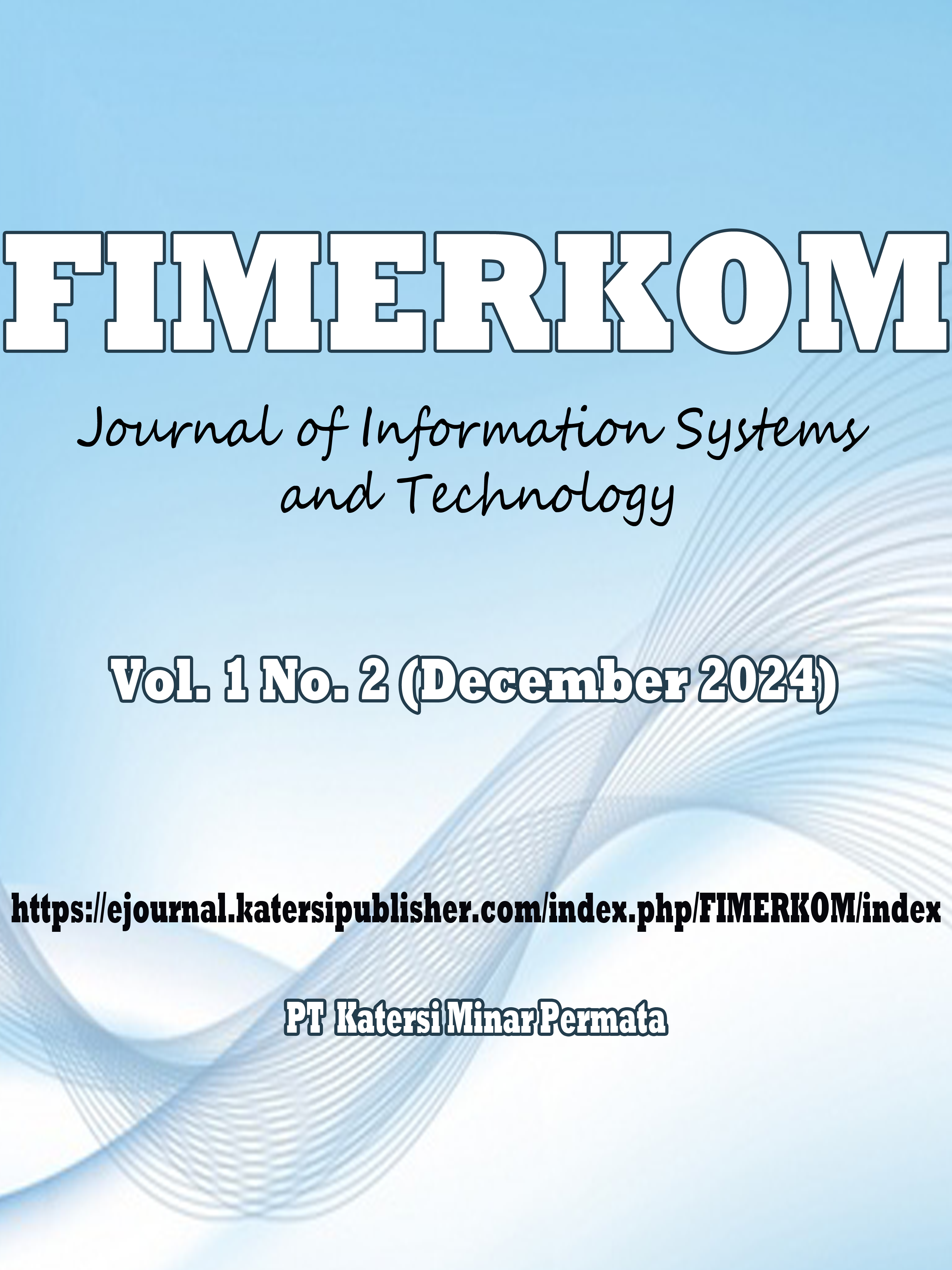Penerapan Bi-Lstm dengan Optimizer ADAM dan Word2vec Untuk Analisis Sentimen
Keywords:
Bi-LSTM, Word2Vec, Adam, Analisis Sentimen, Pembangunan IKNAbstract
Penelitian ini membahas penerapan Bi-LSTM (Bidirectional Long Short-Term Memory) dengan
optimizer Adam dan Word2Vec dalam analisis sentimen publik terkait pembangunan Ibu Kota Negara (IKN)
Indonesia. Dataset terdiri dari 14.317 komentar YouTube yang dikumpulkan menggunakan YouTube Data
API v3 dari berbagai kanal berita dan pemerintah. Tahapan prapemrosesan mencakup case folding,
pembersihan, normalisasi kata slang, penghapusan stopword, tokenisasi, dan stemming. Untuk mengatasi
ketidakseimbangan kelas, teknik SMOTE diterapkan, menghasilkan dataset seimbang dengan 8.912 sampel
untuk kelas positif dan negatif. Word2Vec digunakan untuk merepresentasikan kata dalam bentuk vektor guna
menangkap hubungan semantik antar kata. Model Bi-LSTM dilatih menggunakan optimizer Adam dengan
learning rate 0,001 dan fungsi loss binary_crossentropy. Evaluasi model menggunakan confusion matrix
menunjukkan kinerja yang sangat baik dengan akurasi 98,34%, serta precision, recall, dan F1-score di atas
97% untuk kedua kelas. Hasil ini menunjukkan bahwa kombinasi Bi-LSTM, Word2Vec, dan optimizer Adam
efektif dalam analisis sentimen publik terkait pembangunan IKN. Penelitian selanjutnya disarankan untuk
mengeksplorasi teknik embedding yang lebih canggih seperti BERT atau model berbasis Transformer serta
mengoptimalkan hiperparameter menggunakan Bayesian Optimization atau Genetic Algorithm guna
meningkatkan performa model lebih lanjut.
References
A. W. Wijaya, “Public response to Indonesia’s new capital city: Opportunities and challenges,”
Indonesian Journal of Urban Studies, vol. 5, no. 2, pp. 87–102, 2022.
B. R. Santoso and D. P. Hadi, “Land acquisition and legal challenges in the development of IKN
Nusantara,” Journal of Indonesian Law and Policy, vol. 8, no. 1, pp. 34–50, 2023.
F. Baehaqi and N. Cahyono, "Analisis Sentimen Terhadap Cyberbullying Pada Komentar Di Instagram
Menggunakan Algoritma Naïve Bayes," Indonesia. J. Comput. Sci., vol. 13, no. 1, pp. 1051–1063, 2024,
doi: 10.33022/ijcs.v13i1.3301.
A. Oktavia Praneswara and N. Cahyono, “Analisis Sentimen Ulasan Aplikasi TikTok Shop Seller Center
di Google Playstore Menggunakan Algoritma Naive Bayes,” Indonesian Journal of Computer Science
Attribution, vol. 12, no. 6, p. 3925, 2023.
B. Wicaksono and N. Cahyono, "Analisis Sentimen Komentar Instagram Pada Program Kampus Merdeka
Dengan Algoritma Naive Bayes Dan Decision Tree," JATI (Jurnal Mahasiswa Teknik Informatika), vol.
, no. 2, pp. 2372–2381, 2024, doi: 10.36040/jati.v8i2.9473.
A. Graves, “Long short-term memory networks for sentiment analysis,” IEEE Transactions on Neural
Networks and Learning Systems, vol. 24, no. 4, pp. 599–608, 2013.
Y. Bengio, “Deep learning of representations for unsupervised and transfer learning,” Proceedings of the
ICML Workshop on Unsupervised and Transfer Learning, pp. 17–36, 2012.
T. Mikolov, K. Chen, G. Corrado, and J. Dean, “Efficient estimation of word representations in vector
space,” arXiv preprint arXiv:1301.3781, 2013.
Q. Le and T. Mikolov, “Distributed representations of sentences and documents,” Proceedings of the 31st
International Conference on Machine Learning (ICML), pp. 1188–1196, 2014.
M. A. Saputra and R. Setiawan, “Sentiment analysis on political discourse in Indonesia using Bi-LSTM,”
Indonesian Journal of Data Science, vol. 6, no. 3, pp. 45–62, 2021.
S. T. Wijaya, “Application of Bi-LSTM for sentiment analysis of public policy evaluations,” Journal of
Artificial Intelligence Research, vol. 9, pp. 87–101, 2022.
M. A. Kurniawan and E. P. Pratama, “Text preprocessing techniques for sentiment analysis in Indonesian
language,” IEEE Xplore, 2021.
G. A. Joni, N. Cahyono, A. Baita, and N. Aini, “Rangka Esaf Honda Menggunakan Algoritma Naive
Bayes Dan Super Vector Machine,” vol. 8, no. 5, pp. 10879–10885, 2024.DOI:https://doi.org/10.36040/jati.v8i5.11164.
A. N. Safira, E. Pujastuti, H. Hanafi, B. Setiaji, D. Prabowo, and N. Cahyono, "Sentiment Analysis to
Find Out Positive or Negative Opinions on Ride Hailing Application," in 2023 International Conference
on Informatics, Multimedia, Cyber and Informations System (ICIMCIS), Jakarta Selatan, Indonesia,
, pp. 341-345, doi: 10.1109/ICIMCIS60089.2023.10349083.
M. F. Koto and M. Adriani, “SentiStrength_ID: Enhanced sentiment analysis for Indonesian social media
texts,” Proceedings of the IEEE International Conference on Computational Linguistics, 2020.
N. V. Chawla et al., “SMOTE: Synthetic minority over-sampling technique,” Journal of Artificial
Intelligence Research, vol. 16, pp. 321–357, 2002.
F. Pedregosa et al., “Scikit-learn: Machine learning in Python,” Journal of Machine Learning Research,
vol. 12, pp. 2825–2830, 2011.
A. R. D. Astuti and N. Cahyono, “Analisis Topic Modelling Persepsi Pengguna Internet Menggunakan
Metode Latent Dirichlet Allocation,” Indones. J. Comput. Sci., vol. 12, no. 1, pp. 326–334, 2023, doi:
33022/ijcs.v12i1.3155.
A. S. Pamungkas and N. Cahyono, “Analisis Sentimen Review ChatGPT di Play Store menggunakan
Support Vector Machine dan K-Nearest Neighbor,” Edumatic J. Pendidik. Inform., vol. 8, no. 1, pp. 1–
, 2024, doi: 10.29408/edumatic.v8i1.24114.
R. Rakarahayu Putri and N. Cahyono, “Analisis Sentimen Komentar Masyarakat Terhadap Pelayanan
Publik Pemerintah Dki Jakarta Dengan Algoritma Super Vector Machine Dan Naive Bayes,” JATI (Jurnal
Mhs. Tek. Inform., vol. 8, no. 2, pp. 2363–2371, 2024, doi: 10.36040/jati.v8i2.9472.
R. G. A. Pratama and N. Cahyono, "Comparison of Deep Learning Methods on Sentiment Analysis Using
Word Embedding," JITK, vol. 10, no. 1, pp. 1–8, Jul. 2024. DOI: https://doi.org/10.33480/jitk.v10i1.5280
Downloads
Published
Issue
Section
License
Copyright (c) 2025 Selvi Debi Anita, Nuri Cahyono

This work is licensed under a Creative Commons Attribution 4.0 International License.







